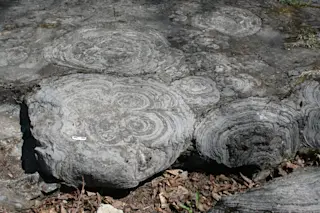Fossilized stromatolites near Saratoga Springs, NY. The structures they form are very close to modern-day bioherms. (Credit: Michael C. Rygel/Wikimedia Commons) The world's largest reef system has even more coral than we thought. Researchers at Australia's Great Barrier Reef say that they have discovered giant mounds of previously undiscovered coral dotting the Australian seabed, interspersed with the existing reef system. Some of these mounds are nearly one thousand feet across and 30 feet high, and have built up over the past ten thousand years or so.
They are called bioherms, and form gradually over time as corals grow, die and calcify. Successive generations of corals simply build on top of their calcified ancestors, creating a huge circular bed on the ocean floor. These bioherms are made from Halimeda, a common species of green algae. The coral hills form between reefs, usually on the westward side where currents filter through the ...














